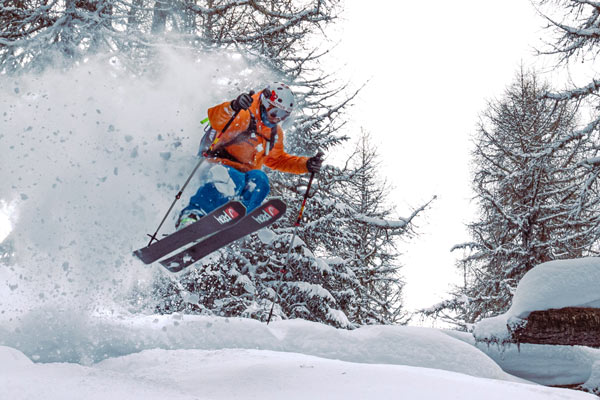The Vallée Blanche, a unique off-piste skiing descent
The Vallée Blanche is an exceptional off-piste ski descent whose reputation is well established and in the heart of the Mont-Blanc massif. The descent of the Vallée Blanche is a long route of more than 20 km starting at the top of the Aiguille du Midi cable car, at 3,842 meters above sea level and connecting Chamonix (1,050m). With Mont-Blanc and the Aiguille du Midi in the background, 2,000 meters of negative elevation in glacial terrain, the descent of the Vallée Blanche is an essential unmarked route for freeriders, thrill seekers. It is a unique glacier course in the high mountains and accessible to experienced skiers and snowboarders.
The descent of the Vallée Blanche, several possible routes
First, at the exit of the cable car, you will have to descend the Aiguille du Midi ridge on foot with your skis on your back. This is a descent of about 100 meters which will allow you to reach the start of the different routes. The descent takes between 4 and 6 hours depending on the route chosen and the weather conditions. Indeed, several itineraries are possible depending on your level of skiing, your experience of high mountains and your physical condition.
The Classic
The Vallée Blanche Classique is the most accessible route of all and presents the least difficulty. About 17 km long, you will first cross the Col du Midi before reaching the Col du Gros Rognon. The descent then continues to the Combe du Géant which is the most delicate passage of this route. Along the crevasses and glaciers, you will arrive at the Refuge du Requin, a very popular place for lunch breaks. The descent continues on the Glacier du Tacul then on the Mer de Glace, without major difficulties. At the level of the Mer de Glace, 2 possibilities are available to you: either you decide to climb the 400 steps to access the Montenvers train and thus return to Chamonix or if the snow cover allows it you can continue the descent on skis to Chamonix.
The Gros Rognon
The Gros Rognon course is increasingly used by skiers wishing to avoid the long crossings of La Classique while having an equally beautiful view. However, the technical skill required in skiing is slightly higher than that recommended for La Classique, as the slopes are steeper and the powder plentiful.
The "real" Vallée Blanche
This course is commonly called thus by the Chamonix in order to refer to the course located on the northern slope of the Gros Rognon, the Vraie Vallée Blanche is much less frequented than the other variants. Indeed, access is more complicated due to the many crevasses present from the start in the combe which then require a minimum of experience in off-piste skiing.
The Petit Envers du Plan
The Petit Envers du Plan route requires good technical skills in off-piste skiing and is accessible to very good skiers. Before embarking on this route, you must make sure that there is good snow cover because you will be moving as close as possible to the seracs and crevasses. During this descent, the view of the Giant of Talèfre basins is breathtaking.
The Grand Envers du Plan
The route of the Grand Envers du Plan is not recommended for people with vertigo, in fact some slopes can exceed 40° and is renowned for its steepest passages. This route is then reserved for skiers in search of adrenaline. You will join La Classique at the Glacier du Tacul after having had your fill of sensations.

Preparing for your descent from the Vallée Blanche
We strongly advise you to do the descent of the Vallée Blanche accompanied by a mountain guide, even if you are an experienced freerider. The latter will be able to share with you his knowledge of the environment so that you do not miss anything of this exceptional descent. In addition, he will be able to choose the route as well as the trajectories according to your level and your desires, provide you with technical advice but also ensure your safety as well as that of the group. It is important to be in good physical condition, the descent lasting between 4 and 6 hours and to know that the weather conditions also have a decisive impact on the technical difficulty of the descent.
You love the region and are considering moving here or purchasing a second home? Trust our real estate agency in Chamonix to bring your project to life.




